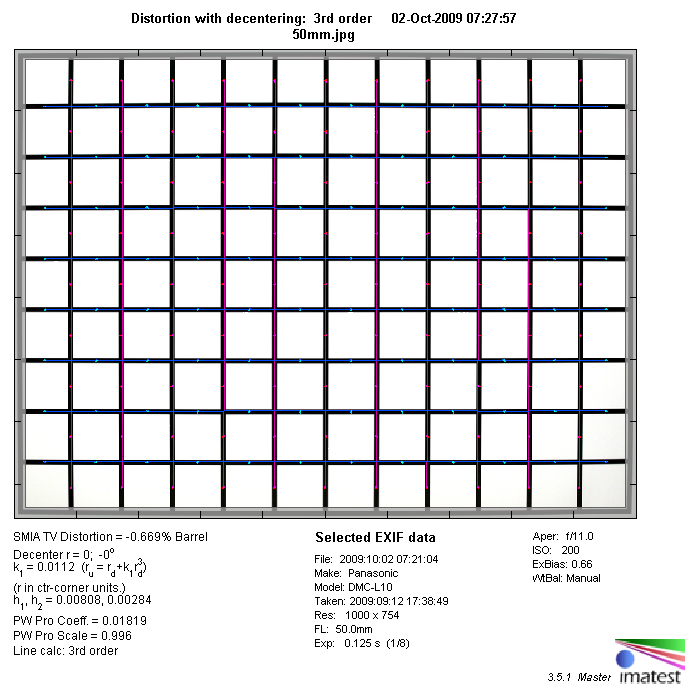|
Olympus Digital Zuiko 50-200mm f/2.8-3.5 ED SWD - Analysis |
|
Lens Reviews -
(Micro-)Four-Thirds
|
|
Page 2 of 3

Distortion
The Zuiko produces only slight distortion throughout the range. It shows a bit of barrel distortion at 50mm changing to slight pincushion distortion from 100mm onwards. Generally this is nothing to worry about.
|
Move the mouse cursor over the focal length text marks below to observe the respective distortion
|
| 50mm |
100mm |
150mm |
200mm |

|
Vignetting
The Zuiko is a dedicated four-thirds lens with a correspondingly small image circle. This shows up at large aperture settings with a vignetting of ~0.8EV in the 100-200mm range which can be visible in critical scenes. Stopping down by 1 f-stop solves the problem. At 50mm vignetting is a non issue.

MTF (resolution)
(revised) The Olympus lens produced very convincing resolution results in the MTF lab. At 50mm the quality is next to perfect across the frame. At 100m the center performance remains excellent from f/2.8 all the way up to f/8 whereas the border quality decreases slightly. It's impressive that the Zuiko is capable of keeping the center performance on very high levels at 150mm and 200mm. The borders suffer a bit more but stay on a very good rating ("just" at max. aperture). Diffraction has a negative impact from f/11 onwards.
Please note that the MTF results are not directly comparable across the different systems!
Below is a simplified summary of the formal findings. The chart shows line widths per picture height (LW/PH) which can be taken as a measure for sharpness.
If you want to know more about the MTF50 figures you may check out the corresponding Imatest Explanations
Chromatic Aberrations (CAs)
High performance lenses are also distinguished from more simple design by the superior correction of color aberrations. This is also true for the Zuiko 50-200mm f/2.8-3.5. Lateral chromatic aberrations (color shadows at hard contrast transitions) are very well controlled. At less than 1px on the average at the image borders you may be able to spot CAs at 100% magnification but this amount is pretty much negligible on prints.

Bokeh
In terms of depth-of-field capabilities the Zuiko behaves like a full format f/5.6-7 lens. This is not overly impressive but in conjunction with a long focal length setting and/or close focus distances it is still possible to isolate objects from their surrounding. The quality of the bokeh (out-of-focus blur) is certainly of interest because the 50-200mm ED is one of the faster Olympus zoom lenses (surpassed by the 35-100mm f/2 of course). It is naturally possible to produce a decent bokeh if the focus spread is big enough (= distance between the primary subject and surrounding objects) but in critical situations - that's a nervous background in conjunction comparatively long focus distances - the quality can leave something to be desired. Here're two examples - one shows a pretty decent bokeh whereas the other one is rather sub-optimal.
The good ...

... and the bad one ...

|